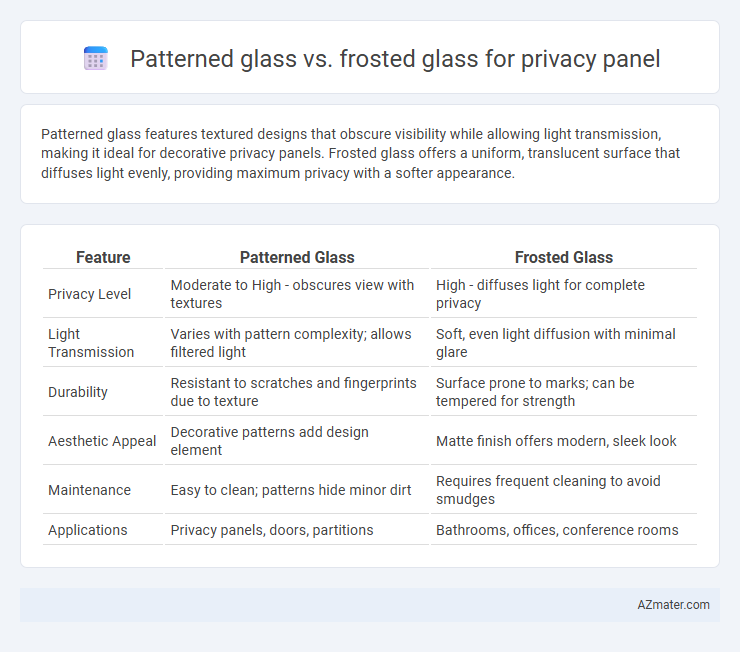Patterned glass features textured designs that obscure visibility while allowing light transmission, making it ideal for decorative privacy panels. Frosted glass offers a uniform, translucent surface that diffuses light evenly, providing maximum privacy with a softer appearance.
Table of Comparison
| Feature | Patterned Glass | Frosted Glass |
|---|---|---|
| Privacy Level | Moderate to High - obscures view with textures | High - diffuses light for complete privacy |
| Light Transmission | Varies with pattern complexity; allows filtered light | Soft, even light diffusion with minimal glare |
| Durability | Resistant to scratches and fingerprints due to texture | Surface prone to marks; can be tempered for strength |
| Aesthetic Appeal | Decorative patterns add design element | Matte finish offers modern, sleek look |
| Maintenance | Easy to clean; patterns hide minor dirt | Requires frequent cleaning to avoid smudges |
| Applications | Privacy panels, doors, partitions | Bathrooms, offices, conference rooms |
Introduction to Privacy Glass Solutions
Patterned glass and frosted glass are popular privacy glass solutions designed to obscure visibility while allowing light to pass through. Patterned glass features textured surfaces that distort images, enhancing privacy without sacrificing natural light. Frosted glass achieves a similar effect through acid etching or sandblasting, creating a uniform translucent finish ideal for confidential spaces.
What is Patterned Glass?
Patterned glass is a type of textured glass featuring raised or indented designs that distort visibility while allowing light to pass through, making it ideal for privacy panels. Unlike frosted glass, which has a uniformly matte surface created by sandblasting or acid etching, patterned glass uses decorative patterns such as rain, reed, or hammered effects to obscure views without sacrificing brightness. This combination of aesthetics and functionality makes patterned glass a preferred choice for offices, bathrooms, and privacy partitions where light diffusion and partial visibility control are essential.
What is Frosted Glass?
Frosted glass is created by sandblasting or acid etching clear glass to produce a translucent, matte finish that diffuses light while obscuring visibility, making it ideal for privacy panels in offices and bathrooms. It offers consistent privacy by blurring shapes and movement without blocking natural light, unlike patterned glass which features decorative designs that may not fully conceal silhouettes. Frosted glass is favored for its minimalist aesthetic and ability to maintain brightness while ensuring confidential spaces remain discreet.
Visual Differences: Patterned vs Frosted Glass
Patterned glass features textured designs or embossed patterns that create varying degrees of opacity, allowing light to pass through while obscuring visibility. Frosted glass offers a uniform, matte finish achieved through sandblasting or acid etching, providing consistent privacy by diffusing light evenly. Visually, patterned glass displays distinct motifs or repetitive textures that can add decorative elements, whereas frosted glass presents a smooth, blurred appearance without distinct design details.
Privacy Levels: Patterned Glass vs Frosted Glass
Patterned glass offers varying degrees of privacy depending on the texture and design, often allowing light transmission while obscuring detailed views. Frosted glass provides a higher and more consistent level of privacy by diffusing light uniformly and preventing any clear visibility through the panel. For applications demanding maximum privacy, frosted glass is typically preferred due to its superior opacity compared to most patterned glass options.
Light Transmission Comparison
Patterned glass offers varied light diffusion depending on the design, typically transmitting 60-80% of natural light while obscuring visibility, making it ideal for privacy panels requiring moderate brightness. Frosted glass scatters light uniformly with a light transmission rate around 70-90%, providing consistent privacy without significant light loss. Both types enhance privacy, but patterned glass combines aesthetic variety with light control, whereas frosted glass ensures even illumination.
Durability and Maintenance Requirements
Patterned glass offers enhanced durability with its textured surface that resists scratches and hides fingerprints, making it ideal for high-traffic privacy panels. Frosted glass, created through acid etching or sandblasting, requires more careful maintenance to prevent surface damage and visible smudges. Both types provide effective privacy, but patterned glass generally demands less frequent cleaning and maintains its appearance better over time.
Aesthetics and Design Versatility
Patterned glass offers intricate textures and designs that create a dynamic interplay of light and shadow, enhancing privacy while adding decorative appeal to interior spaces. Frosted glass provides a sleek, uniform matte finish that diffuses light softly, ideal for minimalist and modern aesthetics requiring subtle privacy solutions. Both options excel in design versatility but patterned glass allows for more artistic expression, whereas frosted glass suits settings where consistent translucency and understated elegance are prioritized.
Cost and Installation Considerations
Patterned glass typically costs less than frosted glass due to simpler manufacturing processes and is easier to install since it often comes in standard thicknesses compatible with most frames. Frosted glass, created through acid etching or sandblasting, demands specialized handling and installation skills, increasing labor costs and time. Considering long-term maintenance, patterned glass tends to resist fingerprints and scratches better, potentially lowering replacement expenses over time.
Choosing the Right Glass for Your Privacy Panel
Patterned glass offers unique textures that distort visibility while allowing natural light to pass, making it ideal for privacy panels in areas requiring both privacy and brightness, like bathrooms or office partitions. Frosted glass provides a consistent, opaque finish that maximizes privacy by blurring shapes and reducing glare, perfect for spaces where complete visual obstruction is needed. Selecting the right glass depends on balancing privacy needs with light transmission and aesthetic preferences, ensuring the panel complements the room's functionality and design.

Infographic: Patterned glass vs Frosted glass for Privacy panel
 azmater.com
azmater.com